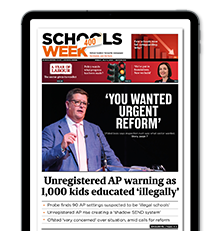Great teachers change children’s lives. But in the face of financial pressure, multi-academy trusts (MATs) are making difficult decisions that may have long-lasting consequences for pupils’ learning.
The stark reality of balancing the books in a MAT was laid bare in the MAT Finance Sector Insight Report 2024, published at the Confederation of School Trusts’ annual conference on 7 November.
The report examined the financial forecasts of 267 trusts representing over 3,000 schools covering the period 2024/25 to 2026/27.
What it showed was that painful but necessary decisions have been made to balance budgets over the next three years, including expected cuts to teaching staff across the sector that are likely to have a major impact in classrooms.
Mounting costs and budget woes
The financial outlook for MATs is troubling. One of the reasons trusts could be planning staff cuts is a nearly 17-per cent forecasted rise in the cost of a teacher over the next three years.
Pre-budget, both national insurance and pension contributions paid by employers, as well as projected pay increases were expected to push the average cost of a teacher from just under £60,000 in 2022/23 to over £70,000 by 2026/27, outside of London.
Painful cuts have been factored in to keep budgets balanced. The stark reality is education leaders are being squeezed from all directions, and something has had to give.
Which trusts are bearing the brunt?
There was a clear divide between how the financial pressures played out in trusts with mostly primary school pupils (at least 75 per cent) versus those with a majority of secondary pupils.
Primary majority trusts predicted a nearly five-per cent cut in teaching staff and almost a 6-per cent reduction in teaching assistants (TAs) by 2026/27. This equates to a significant loss of six teachers and six TAs in a ten-school trust.
Fewer teachers and TAs could mean larger class sizes and less support available for children with additional needs in these trusts.
MATs with mostly secondary school pupils are facing a slightly different challenge. Despite an anticipated three-per cent increase in student numbers, they still expected a one-per cent drop in teacher numbers and a two-per cent reduction in support roles.
This would be six fewer teachers and three fewer TAs in a trust with ten schools.
These small percentage changes might not sound dramatic, but they matter when it comes to giving children the support they need to succeed. The tightrope that trusts are walking is a reminder that there’s no room for complacency, even for those anticipating growth.
Could staff cuts have been avoided?
The figures show the recent announcement of the core schools budget grant (CSBG) provided some much-needed financial relief for trusts, but it came too late for those MATs that have already been forced to make tough choices in their budget projections.
Before the grant announcement on 29 July, 60 per cent of trusts expected to see their revenue reserves fall below the critical five-per cent threshold. After the announcement, that figure dropped to 37 per cent.
While this is a brighter financial outlook for the sector as a whole, it doesn’t change the fact that decisions to reduce staffing levels over the next three years have already been made – and will be hard to reverse against the backdrop of rising costs.
Losing experienced teachers or failing to replace those who leave isn’t just a budgetary decision. It’s a loss of subject expertise, passion and stability in the classroom. Every child deserves consistent, high-quality teaching, and the uncertainty MATs face makes this much harder for them to guarantee.
MATs need more than short-term fixes and last-minute announcements to deliver for children and families. Knowing what funding is coming over a longer period would allow trusts to plan budgets more strategically, retain their best staff and give students the best chance to progress.
The financial situation MATs have forecasted in the next three years is a wake-up call for an overhaul of school funding to better reflect the reality they face.
Delivering a great education is about more than budgets and spreadsheets. But the financial decisions trusts want to make are those which give children a better chance to meet that teacher who encourages them to aim high and achieve.
And the clock is ticking.
Read the ‘MAT Finance Sector Insight Report 2024‘ in full here












Your thoughts